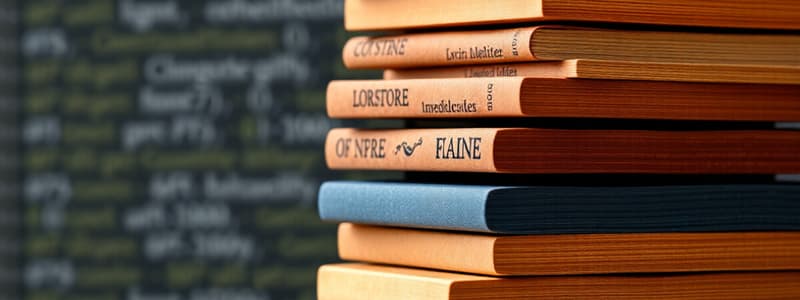Podcast
Questions and Answers
What does the TOP variable represent in a stack?
What does the TOP variable represent in a stack?
- The number of elements currently in the stack
- The index of the bottom element in the stack
- The maximum size of the stack
- The location of the top element in the stack (correct)
Which operation is performed when an element is added to a stack?
Which operation is performed when an element is added to a stack?
- Pop
- Push (correct)
- Peek
- IsFull
What will the IsEmpty function return if TOP is -1?
What will the IsEmpty function return if TOP is -1?
- False, indicating the stack is full
- True, indicating the stack is empty (correct)
- False, indicating the stack has elements
- True, indicating the stack is not empty
In a stack, which element is accessed first when deleting elements?
In a stack, which element is accessed first when deleting elements?
What happens if a push operation is attempted on a full stack?
What happens if a push operation is attempted on a full stack?
How is a stack represented in a linear array?
How is a stack represented in a linear array?
What will be the value of TOP after initializing an empty stack?
What will be the value of TOP after initializing an empty stack?
What does the IsFull function check?
What does the IsFull function check?
What happens when the stack is full during a push operation?
What happens when the stack is full during a push operation?
Which condition indicates that the stack is empty?
Which condition indicates that the stack is empty?
In the dynamic array implementation of a stack, what is used to check if the stack is full?
In the dynamic array implementation of a stack, what is used to check if the stack is full?
What does the pop() operation do in a stack?
What does the pop() operation do in a stack?
What happens if an attempt is made to pop an element from an empty stack?
What happens if an attempt is made to pop an element from an empty stack?
Which statement about stackFull() is true?
Which statement about stackFull() is true?
What is the initial capacity of the stack in the dynamic array implementation?
What is the initial capacity of the stack in the dynamic array implementation?
What is the role of MALLOC in the dynamic stack implementation?
What is the role of MALLOC in the dynamic stack implementation?
What is the primary purpose of the queueFull function?
What is the primary purpose of the queueFull function?
Which of the following describes the main disadvantage of traditional queue implementation?
Which of the following describes the main disadvantage of traditional queue implementation?
In a circular queue implementation, how is the front variable adjusted?
In a circular queue implementation, how is the front variable adjusted?
What does the rear index indicate in a queue?
What does the rear index indicate in a queue?
What happens when a queue reaches its maximum size using a traditional array?
What happens when a queue reaches its maximum size using a traditional array?
Why is the time complexity of queueFull considered O(MAX_QUEUE_SIZE)?
Why is the time complexity of queueFull considered O(MAX_QUEUE_SIZE)?
Which method is NOT typically used to overcome the drawbacks of a traditional queue?
Which method is NOT typically used to overcome the drawbacks of a traditional queue?
What is the outcome when an element is deleted from a traditional queue?
What is the outcome when an element is deleted from a traditional queue?
What does FIFO stand for in the context of queues?
What does FIFO stand for in the context of queues?
What indicates that a queue is empty?
What indicates that a queue is empty?
What happens to the FRONT variable when an element is deleted from the queue?
What happens to the FRONT variable when an element is deleted from the queue?
What is the maximum size of the queue array defined in the queue implementation?
What is the maximum size of the queue array defined in the queue implementation?
What is the purpose of the IsFullQ function?
What is the purpose of the IsFullQ function?
Which statement correctly describes the role of the REAR variable?
Which statement correctly describes the role of the REAR variable?
What would the deleteq() function return when the queue is empty?
What would the deleteq() function return when the queue is empty?
Which of the following is true regarding the addq function?
Which of the following is true regarding the addq function?
What defines a recursively defined function?
What defines a recursively defined function?
Which statement accurately describes the factorial function?
Which statement accurately describes the factorial function?
What is the return value of the factorial function when the input is 0?
What is the return value of the factorial function when the input is 0?
In the recursive procedure to calculate factorial, what happens during the second step?
In the recursive procedure to calculate factorial, what happens during the second step?
What is the significance of base values in a recursive function?
What is the significance of base values in a recursive function?
Which procedure accurately describes the calculation of GCD using recursion?
Which procedure accurately describes the calculation of GCD using recursion?
Which of the following can be a common misconception about recursive functions?
Which of the following can be a common misconception about recursive functions?
When calculating N! recursively, what operation is performed after the call to itself?
When calculating N! recursively, what operation is performed after the call to itself?
What does a deque allow in terms of element manipulation?
What does a deque allow in terms of element manipulation?
In an input-restricted deque, what operation can be performed only at one end?
In an input-restricted deque, what operation can be performed only at one end?
What determines the processing order in a priority queue?
What determines the processing order in a priority queue?
Which statement is true regarding a priority queue's elements with the same priority?
Which statement is true regarding a priority queue's elements with the same priority?
What denotes an empty deque in terms of pointers?
What denotes an empty deque in terms of pointers?
Which representation refers specifically to a priority queue?
Which representation refers specifically to a priority queue?
What happens to a lower priority element in a priority queue when a higher priority element is present?
What happens to a lower priority element in a priority queue when a higher priority element is present?
What is the effect of doubling the capacity in a queue implementation?
What is the effect of doubling the capacity in a queue implementation?
Flashcards
Stack Data Structure
Stack Data Structure
An ordered list where insertions and deletions occur at the same end, called the top.
LIFO (Last-In, First-Out)
LIFO (Last-In, First-Out)
The principle that the last element added to a stack is the first one removed.
Stack Implementation (Array)
Stack Implementation (Array)
Using an array to store stack elements, with variables 'TOP' and 'MAX_STACK_SIZE'
Stack Overflow
Stack Overflow
Error that occurs when trying to add an element to a full stack.
Signup and view all the flashcards
IsEmpty (Stack)
IsEmpty (Stack)
Checking if a stack is empty (TOP = -1).
Signup and view all the flashcards
IsFull (Stack)
IsFull (Stack)
Checking if a stack is full (TOP = MAX_STACK_SIZE -1).
Signup and view all the flashcards
Push Operation (Stack)
Push Operation (Stack)
Adding an element to the top of the stack.
Signup and view all the flashcards
Pop Operation (Stack)
Pop Operation (Stack)
Removing an element from the top of the stack.
Signup and view all the flashcards
Stack Push Operation
Stack Push Operation
Adds an element to the top of a stack. If the stack is full, it prints an error and exits.
Signup and view all the flashcards
Stack Pop Operation
Stack Pop Operation
Removes and returns the element from the top of a stack, treating the stack like a LIFO structure
Signup and view all the flashcards
Stack Full Condition
Stack Full Condition
A condition when a stack's capacity is reached, preventing further elements from being added.
Signup and view all the flashcards
Stack Empty Condition
Stack Empty Condition
A condition when a stack has no elements.
Signup and view all the flashcards
Dynamic Array Implementation of Stack
Dynamic Array Implementation of Stack
A stack implementation where the array size adapts as needed, making the capacity adjustable.
Signup and view all the flashcards
Stack Creation (using dynamic arrays)
Stack Creation (using dynamic arrays)
Allocates memory for a stack using dynamic allocation, initialising its capacity to 1.
Signup and view all the flashcards
IsEmpty Function for a Stack
IsEmpty Function for a Stack
Checks if a stack is empty (no elements present).
Signup and view all the flashcards
IsFull Function for a Stack
IsFull Function for a Stack
Checks if a stack is full (no more space for adding elements).
Signup and view all the flashcards
Recursive Function
Recursive Function
A function that calls itself within its own definition.
Signup and view all the flashcards
Well-Defined Recursive Function
Well-Defined Recursive Function
A recursive function that has a base case (no self-reference) and each recursive call gets closer to the base case.
Signup and view all the flashcards
Base Case (Recursive)
Base Case (Recursive)
A specific input value for which a recursive function does not call itself.
Signup and view all the flashcards
Factorial
Factorial
The product of all positive integers from 1 up to a given positive integer (n).
Signup and view all the flashcards
Factorial Function (Recursive)
Factorial Function (Recursive)
A recursive function that calculates the factorial of a given positive integer using the formula: n! = n * (n-1)! where 0!=1.
Signup and view all the flashcards
GCD
GCD
The greatest common divisor of two integers. It's the largest integer that divides both without a remainder.
Signup and view all the flashcards
Recursive GCD
Recursive GCD
A recursive function to find the Greatest Common Divisor (GCD) of two numbers using a self-referencing approach.
Signup and view all the flashcards
Iterative approach
Iterative approach
A method of solving a problem by performing a series of steps sequentially, one by one.
Signup and view all the flashcards
Queue
Queue
A linear data structure where elements are added at the rear and removed from the front (FIFO - First-In, First-Out).
Signup and view all the flashcards
FIFO
FIFO
The principle that the first element added to a queue is the first one removed.
Signup and view all the flashcards
Queue Representation
Queue Representation
Queues can be implemented using arrays or linked lists.
Signup and view all the flashcards
Queue Operations
Queue Operations
The functions (addq, deleteq, isEmptyQ, isFullQ) used to interact with a queue (to add, remove, check emptiness and fullness).
Signup and view all the flashcards
queueFull() function
queueFull() function
A function that prints an error message and exits the program if a queue is full.
Signup and view all the flashcards
addq(item)
addq(item)
Adds an element (item) to the rear of the queue.
Signup and view all the flashcards
deleteq()
deleteq()
Removes and returns the element from the front of the queue.
Signup and view all the flashcards
Job Scheduling using Queues
Job Scheduling using Queues
Operating systems often use queues to process jobs. Jobs are processed in the order of arrival, unless priority is applied.
Signup and view all the flashcards
Queue Drawback (Sequential)
Queue Drawback (Sequential)
When items are added and removed from a sequential queue, the queue shifts. This potentially leaves empty space at the front but still results in queueFull if the rear reaches maximum possible size.
Signup and view all the flashcards
isEmptyQ
isEmptyQ
Checks if the queue is empty.
Signup and view all the flashcards
isFullQ
isFullQ
Checks if the queue is full.
Signup and view all the flashcards
Time Complexity of shifting queue
Time Complexity of shifting queue
Moving the entire queue in a sequential queue has a worst case time complexity of O(MAX_QUEUE_SIZE).
Signup and view all the flashcards
Circular Queue
Circular Queue
A queue implementation avoids queue shifting by wrapping around the array. This keeps efficient memory use.
Signup and view all the flashcards
Circular Queue - Front
Circular Queue - Front
In a circular queue, the front variable points one position before the front element's location.
Signup and view all the flashcards
Circular Queue - Rear
Circular Queue - Rear
In a circular queue, the rear variable is handled normally; it points to the last element.
Signup and view all the flashcards
Circular Queue Wrapping
Circular Queue Wrapping
A data structure that wraps around the array end in a sequential fashion.
Signup and view all the flashcards
Deque
Deque
A linear data structure that allows elements to be added and removed from both ends (front and rear).
Signup and view all the flashcards
Input-restricted deque
Input-restricted deque
A deque that allows insertions only at one end and deletions at both ends.
Signup and view all the flashcards
Output-restricted deque
Output-restricted deque
A deque that allows deletions only at one end and insertions at both ends.
Signup and view all the flashcards
Priority Queue
Priority Queue
A data structure which prioritizes elements based on their value, processing higher priority elements first.
Signup and view all the flashcards
Priority Queue (one-way list)
Priority Queue (one-way list)
A priority queue representation that uses a linearly connected structure where each item stores not just data but also its priority.
Signup and view all the flashcards
Queue Full
Queue Full
A condition where a queue has reached its maximum capacity and cannot accept further elements.
Signup and view all the flashcards
Circular Array
Circular Array
A data structure that stores data in a sequential manner, with the last and the first element considered to be adjacent.
Signup and view all the flashcards
Dynamic Array
Dynamic Array
A technique used to adjust the capacity of an array as needed, during runtime.
Signup and view all the flashcardsStudy Notes
Stacks and Queues
- A stack is an ordered list where insertions and deletions occur at one end, called the top.
- Last-In-First-Out (LIFO)
- Elements are added and removed from the top.
- The first element inserted is the last to be removed.
Array Representation of Stacks
- Stacks can be represented using a linear array.
- Two variables are used: TOP and MAX_STACK_SIZE.
- TOP holds the location of the top element.
- MAX_STACK_SIZE specifies the maximum capacity.
- TOP = -1 indicates an empty stack.
Stack Operations
Stack Create: Initializes a stack.MAX_STACK_SIZEis often defined as a constant.
IsEmpty(Stack): Checks if the stack is empty. Returnstrueiftop < 0.IsFull(Stack): Checks if the stack is full. Returnstrueiftop >= MAX_STACK_SIZE -1.Push(item): Adds an element to the stack.- If the stack is full, calls
stackFull(). - Otherwise, increments
topand stores theitem.
- If the stack is full, calls
Pop(): Removes and returns the top element.- If the stack is empty, returns
stackEmpty(). - Otherwise decrement
topand return the element.
- If the stack is empty, returns
stackFull(): Handles the scenario if a stack is full.
Stacks using Dynamic Arrays
- Stacks can also be implemented using dynamic arrays.
- This allows the size of the stack to be adjusted during program execution.
REALLOCis often used for dynamic memory allocation.capacityvariable is used to track current size.
Stack Applications: Polish Notation
- An expression is a sequence of operators and operands which evaluate to a single value.
- Infix Expression: Operators are placed between operands. Ex: A + B
- Prefix Expression (Polish Notation): Operators come before their operands. Ex: + AB
- Postfix Expression (Reverse Polish Notation): Operators come after their operands. Ex: AB+
Evaluation of Postfix Expression
- Evaluating a postfix expression is simpler than an infix expression.
- Operands are pushed onto a stack.
- When an operator is encountered, the required number of operands are popped, the operation is performed, and the result is pushed onto the stack.
- The final result is at the top of the stack.
Recursion
- A recursive procedure is one that calls itself directly or indirectly.
- Criteria (base criteria) exist where the procedure does not call itself.
- Each recursive call should move closer to the base criteria.
Factorial Function
- The factorial of a non-negative integer n, denoted by n!, is the product of all positive integers from 1 to n.
- 0! = 1
- n! = n * (n-1)! (for n > 0)
Queues
- A queue is an ordered list where insertions occur at one end(rear) and deletions occur at the other end (front).
- First-In-First-Out (FIFO)
- The first element added is the first element removed.
Queue Representation Using Arrays
- QUEUE is a linear array.
- FRONT points to the front element.
- REAR points to the rear element.
- FRONT=REAR when the queue is empty.
Queue Operations
Queue CreateQ(): Initializes a queue with maximum size.IsEmptyQ(): Checks if the queue is empty. returnstrueiffront == rearIsFullQ(): Checks if the queue is full. Returns true if rear== MAX_QUEUE_SIZE-1addq(item): Adds an item to the queue.deleteQ(): Removes an item from the queue. Returns the item if successful; otherwise an error code.
Circular Queues
- When the queue is full, but there is empty space at the beginning.
- This issue is addressed by using a circular queue implementation.
Priority Queues
- Elements in a priority queue are assigned a priority.
- Elements with higher priority are processed before those with lower priority.
- Elements with the same priority are processed in the order they were added to the queue.
Ackermann Function
- Ackermann function is a recursive function with two arguments.
- The function is defined recursively in terms of itself.
Studying That Suits You
Use AI to generate personalized quizzes and flashcards to suit your learning preferences.




